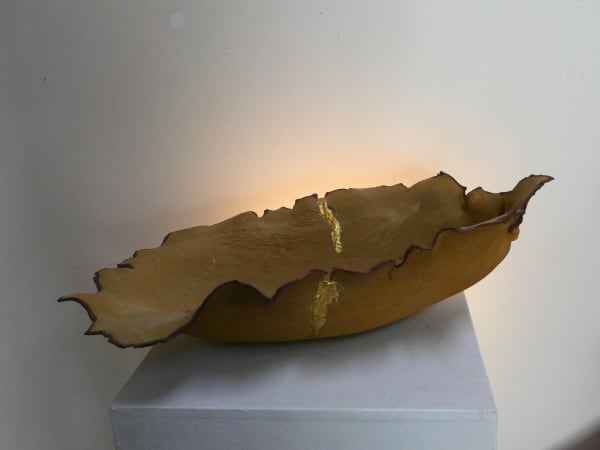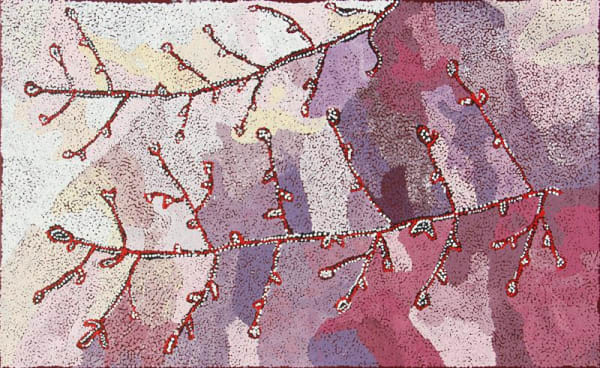Always Was, Always Will Be: In celebration of NAIDOC Week 2020
In celebration of the theme of NAIDOC Week 2020, a wide selection of vibrant Aboriginal art that celebrates that Australia's land Always Was and Always Will Be Aboriginal. Art has been a key factor in numerous Indigenous land rights claims with works often created for the purpose providing graphic and powerful demonstration of Aboriginal people’s long and close history with their lands and their entitlement to them. For Aboriginal people there is little distinction between themselves and their lands; they don’t live on their lands so much as they are the land. Here, the works of 33 artists from Victoria, the Central, Western and Eastern Deserts, the Kimberley, the Pilbara, Arnhem Land, the Tiwi Islands and Queensland demonstrates particular aspects of connection to lands. Most of the exhibiting artists still live on their traditional lands. Some, such as Bugai Whyoulter, Doris Bush, Julie Yajtitja, Nellie Coulthard, Teresa Pumani and Yurpiya Lionel grew up living a very traditional ‘bush’ lifestyle - rarely in contact with Europeans and strongly connected to the seasons, traditional foods, medicines and ceremonial practices. Others such as Gordon Barney, Peggy Madjirroong Griffiths, Patrick Smith Tjapaltjarri, Lizzie Moss Pula and Jeannie Mills Pwerle in their youth lived a semi traditional lifestyle as well as working as station workers and stock men and women on and around their traditional lands. Alison Munti Riley, Barbara Weir, Ben Galmirri Ward, Norm Stewart have been notable activists for their communities in acquiring landrights and fighting the destruction of their lands through agriculture, mining and other incursions. Mornington Island’s Amanda Gabori, Papunya’s Watson Corby Tjungurrayi, Yuendumu’s Athena Nangala Granites and Debbie Napaljarri Brown learnt the art of painting from their famous artist mothers, grandmothers and grandfathers while Victorian artists Cynthia Hardie, Jack Anselmi and Laurel Robinson note that the practice of art has helped to reconnected them to both their culture and country.
-

-

-
 Amanda Jane Gabori DibirdibiCorals at My Fathers Country, 2018acrylic on canvas152 x 101 cmSold
Amanda Jane Gabori DibirdibiCorals at My Fathers Country, 2018acrylic on canvas152 x 101 cmSold
59 7/8 x 39 3/4 in -
 Athena Nangala GranitesNapaljarri-warnu Jukurrpa (Seven Sisters Dreaming) , 2020acrylic on linen122 x 91 cmSold
Athena Nangala GranitesNapaljarri-warnu Jukurrpa (Seven Sisters Dreaming) , 2020acrylic on linen122 x 91 cmSold
48 1/8 x 35 7/8 in -
 Connie BrownYala Yala Tjukurrpa , 2018acrylic on canvas91 x 152 cmSold
Connie BrownYala Yala Tjukurrpa , 2018acrylic on canvas91 x 152 cmSold
35 7/8 x 59 7/8 in -
 Rosalind Tjanyari & Priscilla SingerNgura (Country), 2020acrylic on linen152 x 198 cmSold
Rosalind Tjanyari & Priscilla SingerNgura (Country), 2020acrylic on linen152 x 198 cmSold
59 7/8 x 78 in -
 Rosalind Tjanyari & Priscilla SingerNgura Kuuti (Spirit Country), 2019acrylic on linen152 x 122 cmSold
Rosalind Tjanyari & Priscilla SingerNgura Kuuti (Spirit Country), 2019acrylic on linen152 x 122 cmSold
59 7/8 x 48 1/8 in -
 Cynthia HardieBush Tucker Coolaman, 2020Ceramic - unglazedSold
Cynthia HardieBush Tucker Coolaman, 2020Ceramic - unglazedSold -
 Bugai WhyoulterParrngurr, 2019acrylic on linen91 x 61 cmSold
Bugai WhyoulterParrngurr, 2019acrylic on linen91 x 61 cmSold
35 7/8 x 24 1/8 in -

-
 Gordon BarneyBirnoo Country, 2014natural ochre and pigments on canvas90 x 120 cmSold
Gordon BarneyBirnoo Country, 2014natural ochre and pigments on canvas90 x 120 cmSold
35 3/8 x 47 1/4 in -
 Julie YatjitjaIwantja Tjukitji (Iwantja Soakage), 2019acrylic on canvas152 x 122 cmSold
Julie YatjitjaIwantja Tjukitji (Iwantja Soakage), 2019acrylic on canvas152 x 122 cmSold
59 7/8 x 48 1/8 in -
 Lizzie Moss PwerleDancing Lines, 2020acrylic on linen120 x 150 cmSold
Lizzie Moss PwerleDancing Lines, 2020acrylic on linen120 x 150 cmSold
47 1/4 x 59 1/8 in -
 Maureen Hudson NampitjinpaTali - Sandhills, 2019acrylic on canvas91 x 122 cmSold
Maureen Hudson NampitjinpaTali - Sandhills, 2019acrylic on canvas91 x 122 cmSold
35 7/8 x 48 1/8 in -
 Nellie CoulthardTjuntala Ngurangka (Country with Acacia Wattle), 2019acrylic on linen (Unstretched)101 x 167 cmSold
Nellie CoulthardTjuntala Ngurangka (Country with Acacia Wattle), 2019acrylic on linen (Unstretched)101 x 167 cmSold
39 3/4 x 65 3/4 in -
 Patrick SmithBudgerigah, 2005Etching on paper (framed)39 x 59 cm
Patrick SmithBudgerigah, 2005Etching on paper (framed)39 x 59 cm
15 3/8 x 23 1/4 in4/30$ 1,100.00 -
 Peggy Madijarroong GriffithsJalin-Beasley Knob, 2018natural ochre and pigments on canvas60 x 60 cmSold
Peggy Madijarroong GriffithsJalin-Beasley Knob, 2018natural ochre and pigments on canvas60 x 60 cmSold
23 5/8 x 23 5/8 in -
 Watson Corby TjungurrayiKalipinypa Tjukurrpa, 2019acrylic on linen152 x 183 cmSold
Watson Corby TjungurrayiKalipinypa Tjukurrpa, 2019acrylic on linen152 x 183 cmSold
59 7/8 x 72 1/8 in -
 Yurpiya LionelAnumara, 2020acrylic on canvas80 x 165 cmSold
Yurpiya LionelAnumara, 2020acrylic on canvas80 x 165 cmSold
31 1/2 x 65 in -
 Wulu Marawili Mikariny MuluminyaYathikpa - larrakitj, 2018Earth pigments on Stringybark hollow poleheight 167 cmSold
Wulu Marawili Mikariny MuluminyaYathikpa - larrakitj, 2018Earth pigments on Stringybark hollow poleheight 167 cmSold
height 65 3/4 in -
 Moyurrurra WunungmurraBaliny - larrakitj, 2017Earth pigments on Stringybark hollow pole185 x 14 cmSold
Moyurrurra WunungmurraBaliny - larrakitj, 2017Earth pigments on Stringybark hollow pole185 x 14 cmSold
72 7/8 x 5 1/2 in -
 Norm StewartYalaba Yalaba 2Wooden shieldSold
Norm StewartYalaba Yalaba 2Wooden shieldSold
























